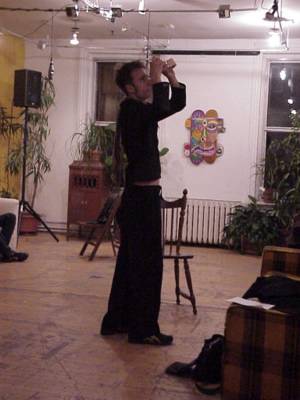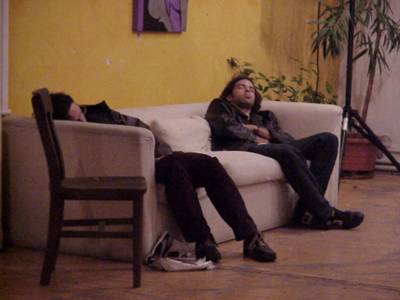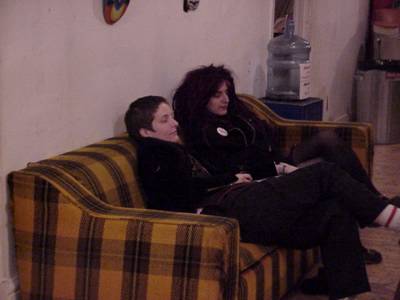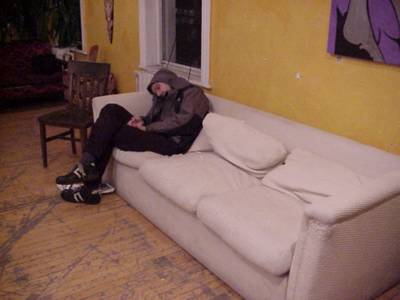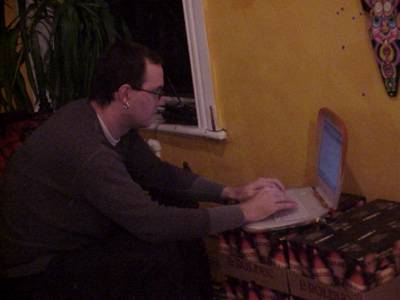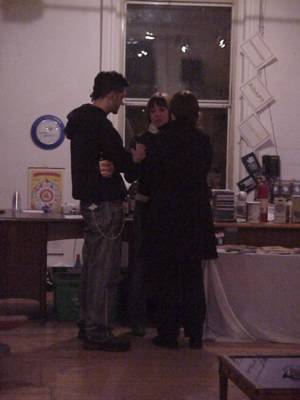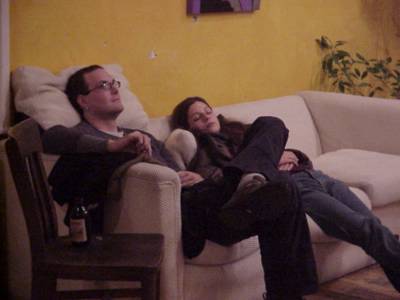Howdy!
I think that things are finally getting back to normal, although I am also getting the strange feeling that "normal" actually means "abnormal." Whatever.
Back, eons ago, I interviewed
Eduardo Kac when he was here for the
Biotech and Art conference. I emailed him the transcript of the interview to see if there were any changes he wanted to make, I haven't heard back from him, so I either have to assume that he, too had a hard drive failure and lost my address, or that everything is a-ok.
I'm going with the later.
I also was thinking of writing some running commentary to go along with the interview, but then decided that the commentary should be separate. So, tomorrow (or maybe later) I will as a separate entry.
If you would like details on who and what
Eduardo Kac is click on
the link.
Interview with Eduardo Kac, October 8, 2004
ZEKE: You said on the walk over here that artists creating life is a new and major thing. Why do you think it is a big thing?
EDUARDO KAC: I think the most fundamental difference is when you create a living being, you're not creating an object, you're creating a subject. And that is a performed departure. When you understand that you're creating a subject, you can't create a subject as you create an object, so everything becomes very different. A subject calls for a relationship, not a nail to hang on a wall, not a pedestal to put it on. It calls for care, for interaction, for love, for nurturing to help it grow healthy. So artwork has never presented this demand before.
ZEKE: Once you get into archivists there are parallels. And then there's the white cube speak about your engagement with your object and so on. I can see that there are similar things happening, with regular art and living art, for lack of better terms.
EDUARDO KAC: Well, no. The one thing is to try to prevent the decay and deterioration of an object, the other is to help a living being to grow and to develop into maturity in a manner that is healthy and fosters a relationship. Why? Because a living being can love you back. An object that is being prevented from decay can't love you back.
ZEKE: OK, where does the idea to create a living organism come from? I could pick up a paintbrush but I'm not a terribly good painter, so I don't. I could pick up a hammer and chisel but I can't sculpt to save my life. Where does the idea come from to make life?
EDUARDO KAC: That is an old idea. That idea has been part of culture, I think, from the beginning.
ZEKE: I mean, specifically in your case.
EDUARDO KAC: Were you there for my presentation?
ZEKE: Yes. I saw you present the progression of your works. Like, "I can make Alba." Where did that come from, when did it happen? I can see from your works that it follows logically from what you have done in the past, but that instant, that "eureka!" moment for the lack of a better cliché.
EDUARDO KAC: I'm not sure I know how to answer that. The "eureka!" moment would imply either a separate instance or a peak in a continuum, and I don't think I have experienced either. Yes and no, that's a complicated question. I'm not really sure how to answer that. Because it's both. It is not what I said but in a way also, it is. So, I'm not really sure how to answer it. It is not because, for me, my creative process is a continuum. I summarized in 40 minutes more than 20 years of work. One thing has taken me to the next without me being able to see… I can talk about the past that way. I can see how I got here, but I can't say that about the next 20 years. I can't do that because it a continuum. I don't have the ability to see it from the outside, that way.
ZEKE: It's the same thing with the gallery. If you asked me the same question, I can say I recognize exactly where the idea for the gallery came from and I can talk about what's going to happen to the gallery in the next five years. There's a bunch of ideas and I don't know which one is going to stick, which one is going to work. I was talking to my friend Bertrand and I have been hammering him for five years saying, "Let's do a show." That is the kernel from which the gallery came. With Alba, I would imagine, there is some sort of kernel that sort of along the same lines as talking to your wife and saying, "Yes. Let's have a child." Sometimes, it's "Ooops, honey I'm pregnant." There's still that kernel there, and that's where it came from. With Alba, is there any sort of...
EDUARDO KAC: It really doesn't come from a radical departure or a peak of any sort. I say "yes" and "no" because in a way it became such a radical departure, it didn't come from it, it became it. That's what I'm saying. It comes from everything I said yesterday. It comes from a long trajectory of looking for alternative modes of communication, studying the human language, intersubjectivity.
ZEKE: To be clear, you have a specific day where you were drinking coffee, were you talking with somebody?
EDUARDO KAC: No. There's no "eureka!" moment. It's an evolving process. But in the larger temporal scale, it did become a peak in the continuum because it is a project unlike any project I've ever engaged in, and quite possibly unlike anything else I might ever…
ZEKE: How do you feel about the reaction you've gotten?
EDUARDO KAC: As I said yesterday, from the beginning, it was to generate public debate but I could not see that the debate would be so vast, that it would continue for such a long time, and that it would happen at such a large physical scale around the globe, trickling down to children's classrooms, as well as PhD classrooms, and everything in between. That I couldn't foresee.
ZEKE: Why not? You were playing God. I would say, "Yeah, that's pretty big stuff once you toss that out there."
EDUARDO KAC: It was not my first transgenic work. It was not my first biological work, either. The first transgenic work I presented was Genesis, the one in which I incurred the Biblical passage. In a way, I don't want to compare the two, although they relate. Genesis has been traveling for the past five years non stop. There are several different versions on the road. It has been shown in Paris, it has been shown in New York, it has been many American cities, it has been shown in Japan, etc. I think Genesis has been shown in more venues than any work of mine. Traveling nonstop for the past five years, it has been shown in a lot of places. It's on view right now in Illinois, there's an invitation to show it in Shanghai next year. It's just where I'm going. To a certain degree, it has been shown more than the bunny. But because the promiscuous semiotics that I spoke of yesterday, Alba became a mean that self-proliferates.
ZEKE: To my mind there is a slight difference, not to diminish the Genesis project, but a bunch of sand in a bottle with some gold stuff and some tablets is completely different.
EDUARDO KAC: That's not the project, that's an aspect of the project. The project was the installation. In which I encoded a biblical passage in bacteria and took the bacteria to the gallery and enabled people on the internet to change the word of God in the body of the bacteria, and that was brought back to the laboratory, revealing the mutation that people did inside the body of the bacteria of the biblical passage.
ZEKE: You talk about Alba is a living subject and Genesis is, despite the transgenic nature of it and to the general public, an art project.
EDUARDO KAC: It begs the question of are the bacteria not subjects? People buy antibacterial soap to kill the bacteria. But, these are living organisms as well.
ZEKE: Dealing with popular perceptions, that's where Alba took off. If you were talk to the general population, or standard issue journalists, that's were the stuff takes off. Dealing with bacteria, an anthrax scare where 20,000 theoretically could die. That would fill up the column inches and make the headlines. Anything less than that, they're not going to be interested.
EDUARDO KAC: It does capture the public's imagination. But of course that's important, but that's not an end in itself. What you are doing as an artist and the continuity of that artistic idiom that you're developing, that's what you leave behind.
ZEKE: To come back, rephrase the question a little bit, with the reaction to stuff, were you happy?
EDUARDO KAC: The reaction to the project was so massive and so diverse that it became extremely interesting. Other works have received critical attention and public commentary and views and whatnot. But there's something, I recognize, that's very different about this project. In the other cases where I had critical commentary and professional commentary. What was unique about Alba was that it went beyond that circle, far beyond that circle which made the diversity of the responses very interesting. So I started to work at that level.
ZEKE: Which can be said about any piece of art.
EDUARDO KAC: Not necessarily, you take a Picasso painting. It's not a piece that by design inserts itself in a circle that has the objective to generate public discussion.
ZEKE: One of the things that made him a household name worldwide was to have that reaction on so many levels with so many different people.
EDUARDO KAC: That may be true, but it wasn't part of the piece. It's not intrinsic to that rectangular shape that's hanging on the wall. It's not a physical part of the piece. It's a consequence, maybe. In my case, we have a design from the outside. At the same time that I imagined her and started to make contacts to find a lab to actually create her, at that moment the idea of public debate was embedded, was an intrinsic part of the piece itself.
ZEKE: Then step back. When it went so far and wide, and you said you weren't expecting that, if it was an intrinsic part of the piece, did you expect it to stay within the academic/professional sphere?
EDUARDO KAC: I expected it to go a little bit beyond, but I didn't expect it to last so long and to be, physically, so global. That's where it became so interesting. I did expect the piece to go beyond the critical and academic circles but I couldn't see how far beyond and I thought the impact would last for a year, but not much longer.
ZEKE: When you're making a piece of art that does touch people, it spreads like wildfire, to make a bad joke, like a virus. Whether it's regular art or non-standard art. That is the intended consequence of any art piece. Unfortunately, many of them don't live up to that standard, and so, as a consequence, don't get that reaction.
EDUARDO KAC: I don't know if that's true. The difference is that when the public discussion around a new idea that is, by design, created as an intervention in the given social practice, that's the case here, that's different. Usually art functions within it's own realm. But the idea of creating a new being and bringing her home definitely operates in the social realm. It bridges the privacy of the gallery, the privacy of the lab, the privacy of the home. By making these bridges, that happens in the public realm. That gesture is an intrinsic part of the piece. For that to be as much part of a work as a brushstroke, it's different from people watching something and talking about that something. That's something external to the work. I'm saying that it's internal to the work, in case. And this is also why it's so different than my other pieces. That which could be a goal in other cases, that goal would be external to the work itself. But in this case, the discussion, the debate, the public presence, is internal to the work.
ZEKE: If it is integral to the piece, but at the same time you didn't anticipate the response, isn't that like saying "I'm using a paintbrush that's blue, but it's coming out purple. And, yeah I think I can live with the purple."
EDUARDO KAC: It's more than the purple. It's more like, wow! Purple!
ZEKE: So is that a good thing?
EDUARDO KAC: Yeah, but particularly in that case, because I'm interested in the unexpected, and when the unexpected happens, you welcome it. It's like improvising in a jam session. Your neighbor just played a note... there's no score. They just played a note. You have to be able to recognize how that resonates with everything else that's going on. And that has to happen immediately so you can play your next note. So it's that ability I'm talking about, that improvisational ability, based on a trajectory that allows you to have that ability. To be able to recognize something that in other cases could be perceived as inconsequential, or ephemeral, or of no particular potential, but being able to recognize what's before you as something that can be further transformed and brought to the fold and put out again and continue...
ZEKE: So I am correct in understanding that you're happy with what the reaction has been?
EDUARDO KAC: Uhh. Whether somebody feels that your work is ethically inadmissible or if they recognize the formal and philosophical seriousness and commitment that I have and the contribution that it makes and everything in between only makes it richer. So I welcome all kinds of responses and I respect them equally.
ZEKE: With the ethical issues, how did you sit them right with yourself?
EDUARDO KAC: That was the greatest challenge. Technologically speaking, there was no mystery to the project. The big challenge was precisely that. I didn't want to do anything that would imply suffering, or torturing, or anything like that. I spent a lot of time studying, I took a course, I read a lot, I interviewed scientists. I did a lot of research to understand. When I was planning the idea… first of all, I was like, "Is this feasible?", "What does this imply?", "Will there be any issues here on that level?". Then it became clear that this gene has been expressed in every type of cell in the lab. And all the organisms that procreated didn't change in any particular way other than having the green light. There has been no change in behavior, no change in form. It became evident that there was no suffering involved. That's when I understood that it would be perfectly fine to do this, not anything. Some people have the false impression that it's all right to do anything. No, you can't. You can't for several reasons. First, life doesn't allow you to. You can't make a marble sculpture out of oil paint or a paper drawing out of wood. Each material has it's logic. Life is a medium that has it's logic so you can't do whatever you want.
ZEKE: One thing that struck me about Alba, it's a step towards somebody saying, "Yeah, I want a kid, blonde with blue eyes, 6'4", and an IQ 180." Alba makes this possible, makes the awareness of it out there, and that future steps... that's where I get very uncomfortable with it. Because it is that sort of future consequence.
EDUARDO KAC: On a technical level, Alba does not lead to that. There is a general impression, which is a false impression, that traits have single causes. In some cases, you can do that, but those are exceptions. Most complex traits have multiple causes. No single gene can account for intelligence.
ZEKE: "Artist creates neon-green bunny." Large headline. Further steps down the line, "Scientist develops technique to guarantee blond hair." Same big headline. I recognize that technically right now it is not possible…
EDUARDO KAC: It raises the awareness of the dangers of such a scenario, yes, and that's part of the issue. But it's not the same thing. To use a marker that attaches itself to every cell of the body is profoundly different from tweaking or adding genes to generate a blue eye.
ZEKE: It is the thin edge of the wedge in public perception. They aren't worried about markers. They say, "Oh, a neon-green bunny. Maybe in twenty years I'll be able to have the child of my dreams." To me, that's when I was asking about ethics, and you wanted to make sure that there was no suffering, that's fine and good, to me there's other implications that come. It's like a butterfly flaps its wings in Beijing and I feel a breeze here in Montréal.
EDUARDO KAC: But that's not going to happen. It will not be possible to have a child with blue eyes or a specific intelligence.
ZEKE: But I'm talking about public perception. Also, I guarantee to you, in twenty years from now, it will be possible.
EDUARDO KAC: I don't think so. Complex traits have multiple causes. To make a gene here and there and achieve these things...
ZEKE: 10 years ago, Bill Gates said, "256 K is enough memory for everybody".
EDUARDO KAC: It is another belief. I don't believe that is possible. Suppose that technically, you could control the blue eye or even affect intelligence, maybe the result is someone who is socially inept. Or dies at a young age. Like you said, actions have consequences. And you're not going to know because you're doing experimentation on humans. I can see how in China because they already do it.
ZEKE: They do it right here in Montréal.
EDUARDO KAC: What do you mean?
ZEKE: You know the about the Raelians cloning. They meet right down the street at their headquarters where they get all their new cult members. It's right down the street.
EDUARDO KAC: They don't have the technology.
ZEKE: They got as much press as you did.
EDUARDO KAC: They don't have a lab.
ZEKE: I haven't looked and I wouldn't talk to them, but it's more the question of public perception. They said they cloned somebody and BAM! they had thousands of journalists following their every move.
EDUARDO KAC: I can see how countries that have different rules would pursue that. You had that Italian specialist in human reproduction working on human cloning. And he was doing that somewhere in Asia where the government has more direct control over things. So, I can see how there would be a human clone, I'm not against that. A clone is not a copy. There's a public perception that a clone is a carbon copy or a photocopy, but it's not. There are a lot of variables that play a role in how an organism develops and this is the same thing that I'm saying. Even if you were able to isolate the sequence that's responsible for blue eyes, I don't know if the sequence being there or not being there will affect the development of that organism in other ways, even though I have never tried. So, in that sense, it's conceivable that in countries like China and Korea, and even in Iran, that have advanced technology and dictatorial control, that human experimentation would happen. Canada has banned the patenting of life. You cannot patent a life form in Canada. I think that's a good thing.
ZEKE: You say you don't like patenting of life forms, but as an artist, you have copyright. Do you have copyrights on Alba?
EDUARDO KAC: No. If you want to make your own green bunny, you can. You can patent a process, not a being. That being is an individual. There is a set of personhood to animals that is different from human personhood. And these are new philosophical ideas, very new, that a lot of people will probably laugh at today, but not in 20 years. So, you wouldn't patent a human being for the same reason you shouldn't patent another living being. You can patent a technique. You could patent a synthetic gene but not a gene... I should not have the right to patent a gene that I take from you. That would be ridiculous. It's a part of you. But if I invent a gene then I should be able to patent it.
ZEKE: Adam Zaretsky pointed out in his talk, he got legal rights to a whole whack of people's genes.
EDUARDO KAC: Well, there are hundreds of companies that have patents on genes that happen to be part of most humans.
ZEKE: What shouldn't be done and what is being done are very frequently two wildly separate things depending on who's doing it and who says you can't do it. There are certain things that should not be done, period and obviously my line is drawn differently than yours is. And what freaks me greatly is how you got there.
EDUARDO KAC: And that's the subject of yesterday's overview.
ZEKE: It's more the thought process in the creation of life in that you say it's not all right to patent but it is all right to clone. That thought process.
EDUARDO KAC: Because patenting is ownership. It's private ownership of something that belongs to humanity. Cloning is just a reproductive method. We have been cloning plants for thousands of years. It's no big deal. It's just another way of propagating life. One retains what is the property of humanity in the interest of people and the other enables new beings to come to life. Cloning is another way of reproducing.
ZEKE: If it's that simple, fine and dandy. But it's not that simple.
EDUARDO KAC: We have been cloning plants for thousands of years.
ZEKE: Slaves were around for a whole whack of time as well. It doesn't make it right.
EDUARDO KAC: You're right. That's not a sufficient argument. If you make a hybrid plant with certain properties, it cannot reproduce itself. If you want to propagate that plant, the only way to do it is by cutting it and planting that cutting and allowing it to propagate. That's cloning. That causes no harm to anyone. If you give a rose on Valentine's Day, that's a clone.
ZEKE: I don't remember whose talk it was during the conference, but hearing some cells scream…
EDUARDO KAC: If the cell is screaming... you take the movement of a cell and translating that into sound and amplifying the sound. That's a human gesture. It's not that the cell itself is screaming. It's like what I did with my plant project. The plant has a voltage fluctuation and, sensing that, I translated it back to the sound that you heard. That is a human gesture. The plant is not making a sound. I'm enabling the plant to make a sound.
ZEKE: You mentioned the personification of animals...
EDUARDO KAC: The personhood of animals, being different than the personhood of humans.
ZEKE: Right now, we don't have the ability to tell if the cloning of a plant is painful, disruptive, anxiety causing.
EDUARDO KAC: A scientist said that a vegetarian is a person who cannot hear the cry of a carrot.
ZEKE: In twenty years, if we can...
EDUARDO KAC: That is a good question. Part of my work is investigating these types of questions. But I don't see morally, in principle, that one reproductive method being better or worse than another. In vitro fertilization, for example.
ZEKE: I have some friends that are going through it and it's costing them way too much money and causing way to much anxiety and they came in with the idea that it's guaranteed.
EDUARDO KAC: But I'm sure that they were told when they came in that it's not the case.
ZEKE: But it's the perception of. Yes they were told...
EDUARDO KAC: You can't blame the procedure for the hope that they have when they arrive at the procedure. It would be very unfair. They were told exactly what was going to happen. And the fact that they were very emotionally involved because of the hopes that they had, that should not be confused with the procedure itself. That they go through a difficult period, of course, they're trying to have a child. Imagine that technique not being there. They would have less of a chance in that case.
ZEKE: There are other ways.
EDUARDO KAC: Why didn't they pursue those?
ZEKE: There's adoption. If you don't have the ability to cross the Atlantic in under an hour, because there's no more Concord, you go with something else and still get there. At which point, a slow boat, that would be nice.
EDUARDO KAC: Those are fine choices but you can't tell the rest of the world to stop doing your thing because that's not how I want you to do it. Don't fly the Concord because I would rather take this other route. If other people want to fly the Concord, they should have the freedom to fly the Concord. It's giving them an option that they don't have to pursue if they don't want to. They are not obliged to do in vitro fertilization. The option is there. They could adopt or they could go childless. Tomorrow, there will be bunch of other techniques. Cloning will be one of them. They may choose or not.
ZEKE: I feel that an awful lot of people are not going to be as responsible once things become easier. Back in the 1930s when airline travel was first happening, people dressed up in their Sunday best and there would be champagne on board. Now you get on the shuttle between Boston and Washington and anybody can walk up onto the plane.
EDUARDO KAC: I don't see a problem with that. It's just the way it is. It's become more common. It's become a part of culture. There's a new plane that goes to space.
ZEKE: There's a difference between responsible use and non-responsible use.
EDUARDO KAC: The research continues and I'm sure that, if they can, they will improve the reproductive rate of in vitro fertilization. Just because it's 1 to 4 now doesn't mean that it will continue to be that way as you pointed out yourself. In twenty years it will not continue to be that way.
ZEKE: However, talking about the larger things like cloning. What is the logical conclusion that happens there? Is it that everybody is saying that it's just a new way of having a kid for those who can't have kids other ways.
EDUARDO KAC: And that's exactly the way I see it. It will be an alternative for those who can't do it in other ways.
ZEKE: To my mind, the ultimate use of it is not going to be for that. It's not going to be for people for who can't do in vitro.
EDUARDO KAC: I don't think so. It will be regulated by demand. Any other purpose will not work. If you try to clone an army and you clone your best soldier. It's not going to work that way.
ZEKE: More in terms as in "I'm rich and famous and extremely powerful and I'm 90 years old and about to kick the bucket". That's where cloning comes in so they continue to live forever.
EDUARDO KAC: But it doesn't work that way. It won't work for that purpose.
ZEKE: Why not?
EDUARDO KAC: That being is a being himself or herself. It's a new being. Nothing of the other person transfers other than the genes.
ZEKE: But the public perception...
EDUARDO KAC: In time it will correct itself because it's false. The first person who is 98 years old and clones himself and then a new person is born who doesn't look like him, doesn't do anything like him, little by little it will become evident and the perception will correct itself. It's getting to the point I'm going to have to go. Look at cartoons in the 1950s. What made people laugh in 1954 was a cartoon of a television host who was a woman from another show - scared because the television host was looking at her. What television is has become very evident to us and the perception corrects itself. Just as you pointed out, just because things are seen one way now doesn't mean they will be seen in the same way 20 years from now.
ZEKE: Thank you very much for your time, I found it very interesting.
EDUARDO KAC: You're welcome.












